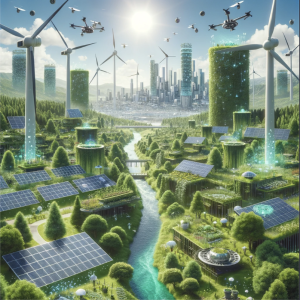
In the past year, major tech conferences have had a buzzword overflow caused by the word “AI.” Realistically, what Google, Microsoft, and Meta mean when discussing AI is Large Language Model (LLM). These are ginormous systems of computing, costing hundreds of millions to set up and run in electricity costs, worker costs, and cooling water costs, among many others.
In many ways, this is a very worrying trend. With LLMs going mainstream, it’s important to question the sustainability of these systems. To show what they cost, not just in economical, but rather in societal and ecological terms.
What do we mean by AI?
AI is, first and foremost, a marketing term. If the name of the field should have been descriptive, it would have probably been called “Data Science.” The field does not really concern itself with the creation of intelligence, instead, it concerns itself with creating simulacra of it, predicting and emulating intelligent behaviour with complicated statistical models and linear algebra.
From a marketing perspective, recent developments like OpenAI’s chatbot, ChatGPT, are fascinating. As Katie Crawford points out in her book The Atlas of AI, we’ve had the basics of this technology for decades. Instead of seeing a technological development, we are seeing a market development, where more and more data and computing power is thrown at these models, and they get better primarily because of that.
To be more precise: the advancements in generative language models from the past decade don’t improve models that are trained on smaller data sets (which is to say, data sets manageable on a home desktop,) instead, they push the barrier of diminishing returns when adding more and more data. GPT-4 is trained on 300 billion words of input text, that is the same amount of text an average village of 10,000 people reads in 31 years, presuming none of them read the same thing. Alternatively, it’s around sixty times the total size of the English Wikipedia. With this amount of data, it is hard to determine if any output is emerging intelligence or just a statistical mirror of human intelligence.
It is from this perspective that we want to take a look at the development of LLMs, exploring the societal and ecological impact of just throwing more computing power at them. Something large companies have been doing at a worrying rate.
How to think about Sustainability
Sustainability is often thought of as no more than a synonym for environmentalism and climate change mitigation, but, in reality, it’s a holistic idea that encompasses environmental, social and economic concerns. While environmentalism mostly focuses on protecting ecosystems and reducing carbon emissions, the idea behind sustainability is to create a balanced and resilient system that can endure and thrive far into the future.
Social sustainability emphasises fostering equitable societies which ensure fair access to resources and opportunities while addressing inequalities and promoting social justice. Economic sustainability, on the other hand, involves creating robust economies that can thrive without compromising the well-being of future generations.

The Dark Side of LLMs
It appears that AI is currently being developed unsustainably, with big companies following the hype and implementing AI-powered systems for every possible use case. These systems and models are getting bigger and bigger, meaning they need more and more energy and more labour pumped into their creation and maintenance as time goes on.
The sustainability issues surrounding LLMs that we want to discuss are twofold: firstly, from a labour perspective and secondly from an environmental one.
AI and Hidden Labour
There has been a growing idea that the intelligence side of AI is not so artificial after all, instead being based on the exploited labour of underpaid human workers all over the world. At their core, all LLM systems rely entirely on having high-quality textual datasets to train on, without which they couldn’t make the “intelligent” predictions that they do.
These datasets, of course, do not appear out of thin air, instead being curated in large part by a hidden workforce who spend their time completing micro-tasks: tagging the sentiment of Tweets, flagging inappropriate language, and deciding whether two sentences are related or not. These workers are not given employment contracts, instead working online, usually through third-party crowd-work platforms which pay varying amounts for different tasks.
This type of work is similar to gig-economy-style employment platforms like Uber and Deliveroo, which both act as intermediaries connecting drivers to independent customers. A lack of fixed employment denies micro-workers the benefits of holiday pay, sick leave, and pension payment plans. As discussed in a Microsoft research paper, many of the people who engage in such crowd-work have disabilities or other reasons for being unable to work more traditional jobs, meaning that they are exploitatively coerced into completing these tasks with few alternatives available to them to earn a living.
In addition to these click-workers, AI needs hardware to be trained and maintained on, the production of which also comes at a significant human cost. According to a 2023 NPR reportage, rare-earth material mines, like the Shabara Cobalt Mine in the DRC, are notorious for slavery-like working conditions and similarly unregulated employment contracts with no fixed wage and no benefits. Entire towns with hundreds of thousands of inhabitants have been bulldozed to allow mines like Shabara to set up shop, and, somewhat ironically, this leaves the surrounding population with few other options for work than in the exact mine that just uprooted their life and livelihood. The cobalt generated from these mines is used in virtually all lithium-ion rechargeable batteries, as well as in microchip production, meaning the majority of AI systems are running (at least indirectly) on some form of slave labour. Certainly, this is a problem with big tech in general, but as AI gets more prevalent it will account for a larger share of the responsibility.

Environmental Impact
ChatGPT uses a ton of electricity. Exactly how much is hard to know, as OpenAI is not exactly open about the state of their AI, but across different estimations, the total amount of electricity is usually in the single-digit terawatt-hours per year. In the grand scheme of things, this is not that much. Bitcoin’s blockchain uses two orders of magnitude more, but so does the entirety of Denmark.
Instead of being worrying on its own, as Alex de Vries points out in his article for Joule, this number should be seen as an indication of the number of things that need to happen for ChatGPT to function, and what an “AI-powered” future, where google search is asking GPT-5, where your document processor has a chatbot, or where all code autocomplete is an LLM, might look like. De Vries points out that the energy consumption of generative AI models might exceed that of Bitcoin (or Denmark) in as little as five years, where the amount of energy that can be consumed is less likely to be limited by what companies want to make than by what chip manufacturers can produce, as even only Google adding the current generation of generative AI to every search (as they are currently promising) would be enough to hit that number.
The production of these chips themselves, of course, comes at a cost to the environment in addition to people. Rare earth metals have to be mined, and mining tends to cause dramatic harm to the surrounding environment, and the climate as a whole. For her previously mentioned book, The Atlas of AI, Crawford travels to a Lithium mine in Nevada and shows the environmental impact a large-scale operation has. Polluting its environment with chemicals used during the extraction. These rare earth metals are not just needed for the servers that run ChatGPT either, but also for the increasingly powerful tensor chips in consumer electronics needed to run models locally.
Final Thoughts
“There’s no such thing as a free lunch”
Age-old Adage
There is always some form of payment for anything perceived as free, which is made extremely evident by the amount of free-to-use AI applications floating around the internet (e.g. ChatGPT, Midjourney, etc.). The companies running these products must be making money somehow, and there must be a hidden cost somewhere down the line. In this case, it’s the unsustainable exploitation of working people and the environment. Across both click-work and mining, vulnerable people with few employment options can be coerced into precarious positions which are often underpaid, unregulated and unsafe, while the environmental cost also begins to take a toll on their lives, causing more extreme weather events and more frequent natural disasters.
The real issue plaguing sustainable AI development is the impossibility of ethical consumption under a capitalist system which puts profit ahead of people. In this situation, using any kind of energy and computing power, especially at a large scale, necessarily involves exploited labour and environmental impact. In effect, more sustainable AI requires a more sustainable economic system.
In the future, instead of throwing AI into everything under the sun because it’s trendy, companies should carefully evaluate if the application’s utility warrants the impact that the system will have.


